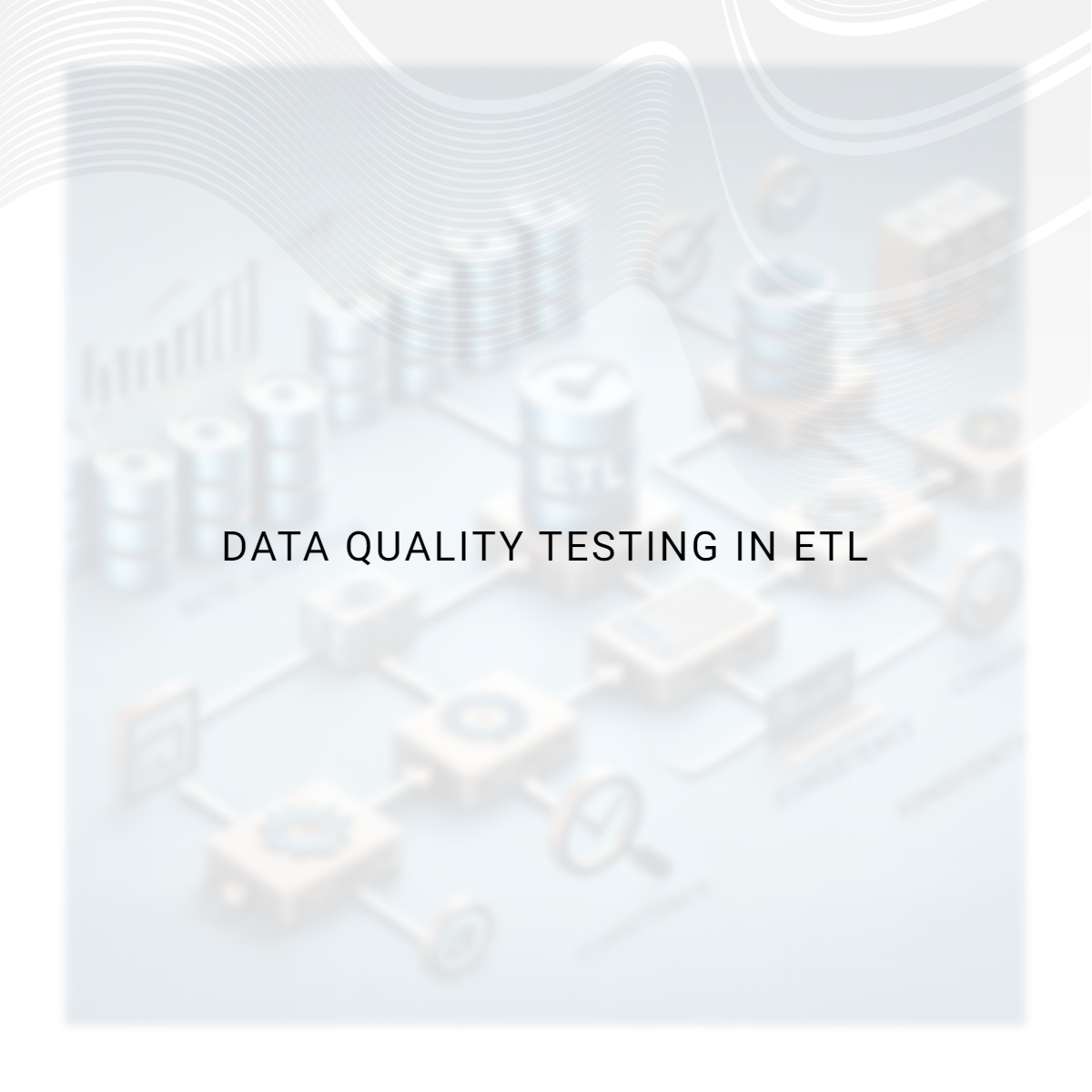Data Quality Testing in ETL
Mon Sep 30 2024

Extract, Transform, Load, or ETL, is the acronym for the process of gathering data from several sources, transforming it into a standardized and functional format, and finally inserting it into a target database or data source. It helps businesses to aggregate and analyse vast amounts of data from multiple platforms, which makes it essential to data integration and management.
Information is obtained from a variety of sources, including files, databases, APIs, and web scraping, during the extraction phase. The retrieved data is cleaned, validated, and standardized during the transformation stage to ensure accuracy and consistency. During the loading process, the updated data is entered into a target system for reporting and analysis. Businesses must use ETL processes to improve the quality of their data, and gain insightful knowledge from their.
Data Quality Testing in ETL ensures that the data being moved from source to target systems is accurate, consistent, complete, and meets the required standards. It is a crucial aspect of the ETL process as it guarantees the reliability and usability of data for decision-making. Here’s a comprehensive guide to perform data quality testing in ETL:
Steps involved Data Quality Testing in ETL
1. Define Data Quality Requirements
Accuracy: Ensure the data is correct and free from errors.
Consistency: Verify that data is consistent across different sources and target systems.
Completeness: Check that all required data is present.
Timeliness: Ensure the data is up-to-date and delivered within the required timeframe.
Uniqueness: Make sure there are no duplicate records.
Integrity: Verify referential integrity and data relationships.
2. Create a Data Quality Test Plan
Identify Test Scenarios: Define specific scenarios to be tested, such as data type validation, range checks, and null value checks.
Define Test Cases: Create detailed test cases for each scenario.
Set Acceptance Criteria: Define what constitutes a pass or fail for each test case.
3. Prepare Test Data
Select Sample Data: Choose representative data samples that cover all possible data variations.
Create Test Data: Generate or extract test data from production-like environments.
4. Execute Data Quality Tests
Data Completeness Testing: Ensure all required data is present in the target system.
SQL Ex: SELECT COUNT(*) FROM SourceTable;
SELECT COUNT(*) FROM TargetTable;
Data Accuracy Testing: Verify that the data in the target system matches the source data.
SQL Ex: SELECT SourceColumn, TargetColumn
FROM SourceTable
JOIN TargetTable ON SourceTable.Key = TargetTable.Key
WHERE SourceColumn != TargetColumn;
Data Consistency Testing: Check for data consistency across different systems.
SQL Ex: SELECT * FROM SourceTable
EXCEPT
SELECT * FROM TargetTable;
Data Integrity Testing: Validate primary and foreign key constraints, unique constraints, and referential integrity.
SQL Ex: SELECT COUNT(*), PrimaryKeyColumn
FROM TargetTable
GROUP BY PrimaryKeyColumn
HAVING COUNT(*) > 1;
Data Timeliness Testing: Ensure the data is up-to-date and delivered within the required timeframe.
SQL Ex: SELECT MAX(LoadDate) FROM TargetTable;
Data Uniqueness Testing: Check for duplicate records in the target system.
SQL Ex: SELECT ColumnName, COUNT(*)
FROM TargetTable
GROUP BY ColumnName
HAVING COUNT(*) > 1;
5. Validate Results
Compare Results: Compare the results of your tests with expected outcomes.
Log Defects: Record any discrepancies or defects found during testing.
Analyse Issues: Identify the root causes of any issues and take corrective actions.
6. Report and Document
Test Summary Report: Document the test results, including passed and failed test cases.
Defect Report: Provide detailed reports and analysis of any defects or issues found.
Documentation- Make sure to keep thorough records of test cases, test outcomes, and any identified defects.
Common Data Quality Issues in ETL
Data quality issues in ETL processes can arise from various sources and can significantly impact the accuracy and reliability of data. Here are some common data quality issues and how to address them:
- Missing Data: Data fields that should contain values are empty or null
Causes: Incomplete data entry at the source or Data loss during extraction or transformation.
2. Duplicate Data: Multiple records that represent the same entity.
Causes: Multiple data entry points or Poor data integration from different sources
3. Inconsistent Data: Data that should be uniform but varies across sources or entries.
Causes: Different formats or standards in different source systems or Manual data entry errors.
4. Invalid Data: Data that does not conform to the expected format or range.
Causes: Incorrect data entry or Data corruption.
5. Data Integrity Issues: Relationships between data entities are not maintained (e.g., foreign key constraints are violated).
Causes: Incorrect data mappings or Incomplete data loads.
6. Data Type Mismatches: Data types in the target system do not match those in the source system.
Causes: Incorrect data type definitions in the target schema or Inadequate transformation rules.
7. Data Accuracy Issues: Data does not accurately represent the real-world entities or events.
Causes: Human error during data entry or Outdated or incorrect source data.
8. Timeliness Issues: Data is not available within the required timeframe.
Causes: Delays in data extraction, transformation, or loading or Latency in source systems.
9. Data Transformation Errors: Errors introduced during the transformation process.
Causes: Incorrect transformation logic or Bugs in ETL scripts or tools.
10. Data Completeness Issues: Not all required data is extracted, transformed, or loaded.
Causes: Incomplete extraction queries or Data truncation during loading.
Best Practices for Data Quality Testing in ETL
1. Use Production-like Data: Test with data that closely resembles production data to ensure realistic testing conditions.
2. Automate Where Possible: Use automation to handle repetitive and complex testing tasks, improving efficiency and accuracy.
3. Validate Incremental Loads: Ensure that incremental data loads are thoroughly tested to verify that only changed data is loaded correctly.
4. Document Thoroughly: Be sure to keep thorough records of test cases, test results, and any defects found to facilitate troubleshooting and future reference.
5. Perform Regression Testing: Re-test after any changes to ensure that the ETL process still works correctly and maintains data quality.
Conclusion:
By addressing these common data quality issues and implementing best practices, you can significantly improve the reliability and accuracy of data in your ETL processes. And following these steps and best practices, you can effectively perform data quality testing in ETL processes to ensure that the data being moved is accurate, consistent, complete, and reliable for decision-making.


